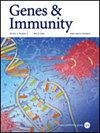LncRNA测序揭示了lncRNA介导的ceRNA网络在阴茎鳞状细胞癌中的重要作用。
IF 4.5
3区 医学
Q1 GENETICS & HEREDITY
引用次数: 0
摘要
阴茎鳞状细胞癌(PSCC)越来越常见,对男性健康构成严重威胁,尤其是在发展中国家。长非编码RNA(lncRNA)在PSCC进展中的功能仍是一个谜。因此,我们探讨了竞争性内源性RNA(ceRNA)网络中的lncRNA在PSCC肿瘤进展中的意义。我们对5个健康样本和6个肿瘤组织样本进行了lncRNA测序。利用miRcode、LncBase、miRTarBase、miRWalk和TargetScan,我们构建了一个由差异表达的lncRNA、miRNA和mRNA组成的ceRNA网络。分析结果显示,ceRNA网络由4个lncRNA、18个miRNA和38个mRNA组成,它们的上游调控因子--lncRNA MIR205HG、MIAT、HCP5和PVT1在PSCC中均有升高。免疫组化染色证实,受4种lncRNAs正向调控的细胞增殖相关基因TFAP2C、MKI67和TP63在肿瘤组织中显著过表达。免疫分析显示,PSCC中巨噬细胞和T细胞浸润明显上调。我们的研究发现了PSCC的lncRNA-miRNA-mRNA ceRNA网络,揭示了关键lncRNA调控PSCC进展的可能分子机制及其与免疫抑制性肿瘤微环境的联系。ceRNA网络为阐明PSCC的发病机制提供了一个新的视角。本文章由计算机程序翻译,如有差异,请以英文原文为准。

LncRNA sequencing reveals an essential role for the lncRNA-mediated ceRNA network in penile squamous cell carcinoma
Penile squamous cell carcinoma (PSCC) is becoming increasingly common and posing a severe threat to men’s health, particularly in developing countries. The function of long non-coding RNAs (lncRNAs) in PSCC progression remains mysterious. Therefore, we explored the significance of lncRNAs in the competing endogenous RNA (ceRNA) network in PSCC tumor progression. The 5 healthy and 6 tumor tissue samples were subjected to lncRNA sequencing. Using miRcode, LncBase, miRTarBase, miRWalk, and TargetScan, we constructed a ceRNA network of differentially expressed lncRNAs, miRNAs, and mRNAs. Our analysis resulted in a ceRNA network consisting of 4 lncRNAs, 18 miRNAs, and 38 mRNAs, whose upstream regulators, the lncRNAs MIR205HG, MIAT, HCP5, and PVT1, were all elevated in PSCC. Immunohistochemical staining confirmed that cell proliferation-related genes TFAP2C, MKI67, and TP63, positively regulated by 4 lncRNAs, were considerably overexpressed in tumor tissues. Immune analysis revealed a significant upregulation in macrophage and exhausted T cell infiltration in PSCC. Our study identified a lncRNA-miRNA-mRNA ceRNA network for PSCC, revealing possible molecular mechanisms involved in the regulation of PSCC progression by key lncRNAs and their connections to the immunosuppressive tumor microenvironment. The ceRNA network provides a novel perspective for elucidating the pathogenesis of PSCC.
求助全文
通过发布文献求助,成功后即可免费获取论文全文。
去求助
来源期刊

Genes and immunity
医学-免疫学
CiteScore
8.90
自引率
4.00%
发文量
28
审稿时长
6-12 weeks
期刊介绍:
Genes & Immunity emphasizes studies investigating how genetic, genomic and functional variations affect immune cells and the immune system, and associated processes in the regulation of health and disease. It further highlights articles on the transcriptional and posttranslational control of gene products involved in signaling pathways regulating immune cells, and protective and destructive immune responses.
 求助内容:
求助内容: 应助结果提醒方式:
应助结果提醒方式:


